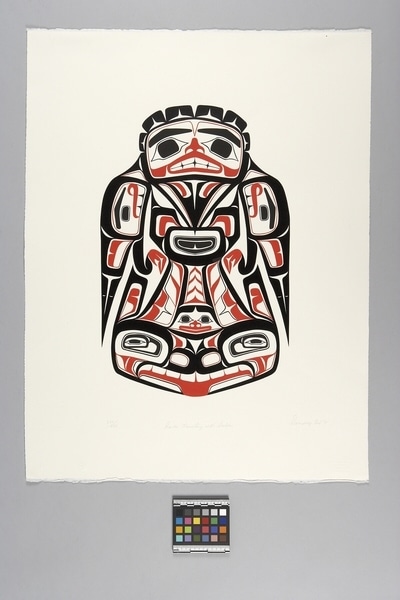Raven Travelling with Sculpin Item Number: Nb22.80 from the MOA: University of British Columbia

Description
Symmetrical design is predominantly black with red detail. All images are contained in a basically rounded rectangle. There is a head at the top centre protruding from the bottom, a horizontally elongated frontal face with a protruding tongue and a salmon-trout head eye motif, and a small frontal face with three split u's above up to the ovoid with a nearly solid inner ovoid. Frontal face at the top has a series of six split u's along the top of the head with a triangle shape below the chin. Two profile faces are on either side with a red curled s-shape above the teeth row and having the tail come to a point and the forelimb go to the centre. Pencil inscription across the bottom reads '207/225 Raven travelling with Sculpin Dempsey Bob '79'. There are three embossed marks along the bottom edge, from the right: 'The Gallery Collection', a circle with a vertical line, and a discontinuous horizontal line. The print is on a vertically rectangular, near white paper piece with a deckle edge top and bottom.
History Of Use
Northwest Coast serigraphs are a contemporary art form, deriving from early 20th century drawings of traditional crest and decorative designs, commissioned by anthropologists and undertaken by artists such as Charles Edenshaw. Residential schools reinforced the medium, while discouraging the use of traditional themes. An important series of traditional designs in coloured pencil and watercolour were done by Mungo Martin for UBC in 1949-50. The 1960's saw the rapid growth of prints, first in unlimited poster editions, and later with the establishment of the Gitanmaax School of Northwest Coast Indian Art at 'Ksan (1967), and of the Northwest Coast Indian Artists Guild (1977), limited edition art runs became the standard. Northwest Coast silkscreen prints are part of the mainstream art market, as well as, functioning within the native context as potlatch gifts, and commemorative prints. Although, there are distinctive regional styles, individual artists may work in several styles, or apply unique themes and variations to specific works.
Cultural Context
contemporary art
Item History
- Made by Dempsey Bob (Maker) in British Columbia, Canada during 1979
- Owned by Vancouver Museums & Planetarium & Association Gift Shop before April 18, 1980
- Received from McLean Foundation (Funding source) and Vancouver Museums & Planetarium & Association Gift Shop (Seller) on April 18, 1980
What
- Name
- Raven Travelling with Sculpin
- Identification Number
- Nb22.80
- Type of Item
- Manufacturing Technique
- silkscreened
- Overall
- height 66.0 cm, width 50.3 cm, depth 0.1 cm
Who
- Culture
- Tahltan and Tlingit
- Creator
- Dempsey Bob (Maker)
- Previous Owner
- Vancouver Museums & Planetarium & Association Gift Shop
- Received from
- McLean Foundation (Funding source) and Vancouver Museums & Planetarium & Association Gift Shop (Seller)
Where
- Holding Institution
- MOA: University of British Columbia
- Made in
- British Columbia, Canada
When
- Creation Date
- during 1979
- Ownership Date
- before April 18, 1980
- Acquisition Date
- on April 18, 1980
Other
- Item Classes
- works on paper
- Condition
- good
- Accession Number
- 0625/0004